Matcha
Matcha Creation Unveiled: How Matcha Tea Is Made

Have you ever wondered how matcha tea is made? Well, it just so happens that we have all the answers for you.
In this guide, we will take you through the fascinating process of creating this delightful and rejuvenating beverage. From the cultivation of the matcha tea leaves to the final brewing, we will explore every step with you.
We’ll uncover the secrets behind the shade-growing process, the art of harvesting and steaming the leaves, and the health benefits of this vibrant green tea.
Whether you’re a tea enthusiast or someone who wants to serve the perfect cup to others, this introduction will set the stage for your journey into the world of matcha tea.
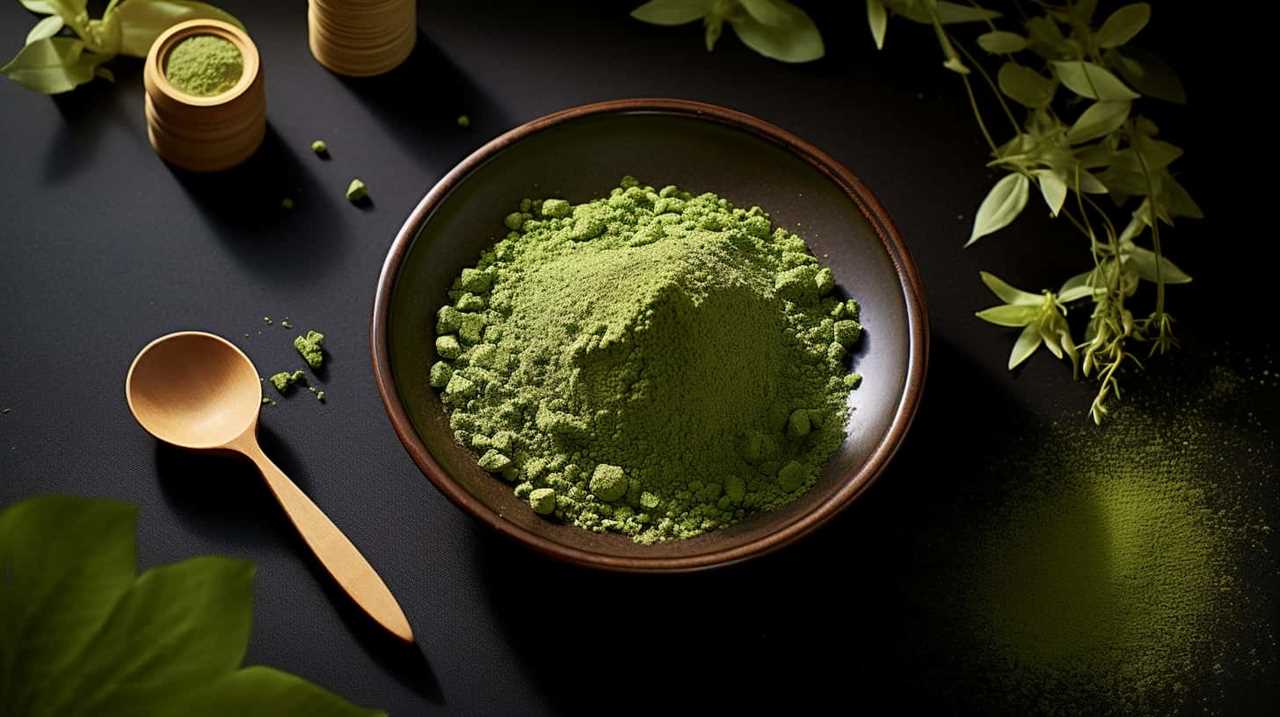
So, let’s begin!
Key Takeaways
- Matcha tea originated in the Tang Dynasty in China and was refined by the Japanese.
- Only the youngest and most tender leaves are handpicked for matcha tea.
- Matcha tea is made by steaming the leaves immediately after harvesting to prevent oxidation and preserve its vibrant green color and fresh taste.
- Matcha tea is produced by grinding tencha leaves into matcha powder using stone grinding techniques.
History of Matcha Tea
In the history of Matcha Tea, we can trace its origins back to the Tang Dynasty in China. The evolution of matcha can be seen through its cultural significance, as it has played a prominent role in Japanese tea ceremonies for centuries.
During the Tang Dynasty, tea leaves were steamed and formed into bricks for easy transportation. This method of preparing tea eventually made its way to Japan, where it underwent further refinement. The Japanese began to grind the tea leaves into a fine powder, resulting in the creation of matcha as we know it today.
Matcha quickly gained popularity in Japan, becoming an integral part of Zen Buddhism and the tea ceremony. The preparation and consumption of matcha became a meditative practice, symbolizing harmony, respect, and tranquility.

The cultural significance of matcha extends beyond its use in tea ceremonies. It has become a staple in Japanese cuisine, used in various sweets, desserts, and even savory dishes. Matcha is also celebrated for its health benefits, as it’s rich in antioxidants and provides a calm, focused energy.
Today, matcha continues to evolve and gain popularity worldwide. Its unique flavor, vibrant green color, and cultural significance make it a beloved beverage enjoyed by people all over the globe.
As we delve into the process of making matcha tea, it’s important to appreciate its rich history and cultural significance.
Cultivation of Matcha Tea Leaves
When it comes to the cultivation of matcha tea leaves, there are two key factors that play a crucial role: soil and climate. The quality of the soil and the specific climate conditions greatly impact the flavor and characteristics of the tea.

Additionally, the harvesting and processing techniques used are also important in ensuring that the tea leaves are of high quality and able to produce the vibrant green powder that’s matcha.
Soil and Climate Factors
To cultivate high-quality matcha tea leaves, we rely on the harmonious interplay between the soil and climate conditions. The combination of specific soil composition and climate variations greatly affects the taste, aroma, and overall quality of matcha tea. Here are five important factors to consider:
- Soil composition: Matcha tea thrives in well-drained, fertile soil with a slightly acidic pH level. The right balance of nutrients like nitrogen, potassium, and phosphorus is crucial for healthy leaf growth.
- Temperature: Matcha tea prefers cooler temperatures, ideally ranging between 60 to 70 degrees Fahrenheit. This helps the leaves develop a rich flavor and vibrant green color.
- Sunlight exposure: Matcha tea plants require a delicate balance of sunlight and shade. Partial shade helps slow down the growth process, leading to tender leaves with enhanced flavor.
- Rainfall: Adequate rainfall is essential for matcha tea cultivation. Consistent moisture levels ensure optimal growth and prevent the leaves from becoming bitter.
- Altitude: Higher altitudes provide cooler temperatures, which contribute to matcha tea’s desirable characteristics.
Understanding these soil and climate factors is crucial in producing exceptional matcha tea leaves.
Now, let’s delve into the next section about harvesting and processing techniques.

Harvesting and Processing Techniques
One crucial step in the cultivation of matcha tea leaves is implementing specific harvesting and processing techniques. These techniques play a significant role in ensuring the quality and flavor of the final product.
To begin with, matcha tea leaves are cultivated in soil with a balanced acidity level, usually around pH 5.5 to 6.5. This optimal soil acidity allows for the absorption of essential nutrients, resulting in healthy and vibrant tea plants.
When it comes to harvesting, only the youngest and most tender leaves are carefully handpicked. This ensures that the tea leaves have a high concentration of nutrients and a delicate flavor.
After harvesting, the tea leaves undergo a meticulous processing method to prevent oxidation. By steaming the leaves immediately, the oxidation process is halted, preserving the vibrant green color and fresh taste of matcha tea.
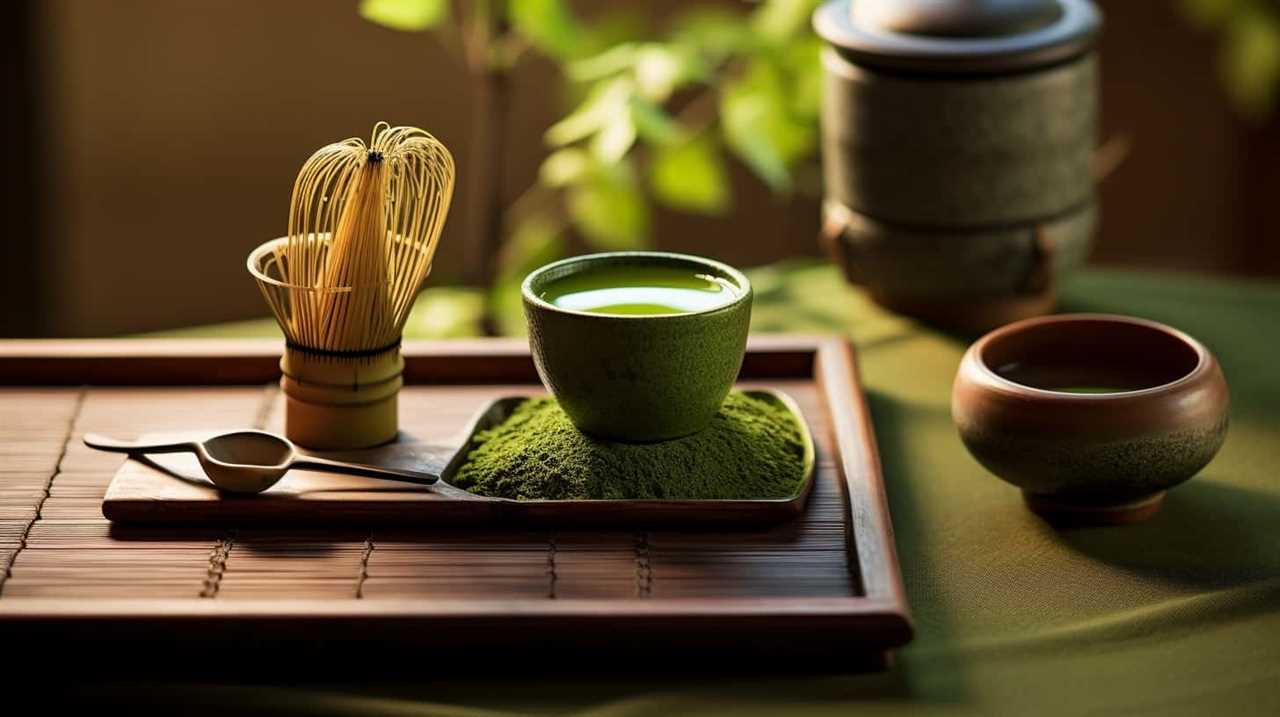
Shade-Growing Process
When it comes to the shade-growing process of matcha tea, there are several important points to consider.
First, the shade provides numerous benefits, such as slower growth and increased chlorophyll production, which contribute to the vibrant green color and unique flavor of matcha.
Additionally, the shade helps in the development of tea flavor by enhancing the amino acid content, which adds a rich and umami taste to the tea.
Benefits of Shade
There are several benefits that come with the shade-growing process of matcha tea production. Shade growing techniques involve covering the tea plants with shading material to reduce sunlight exposure, which affects the flavor, texture, and overall quality of the tea leaves.
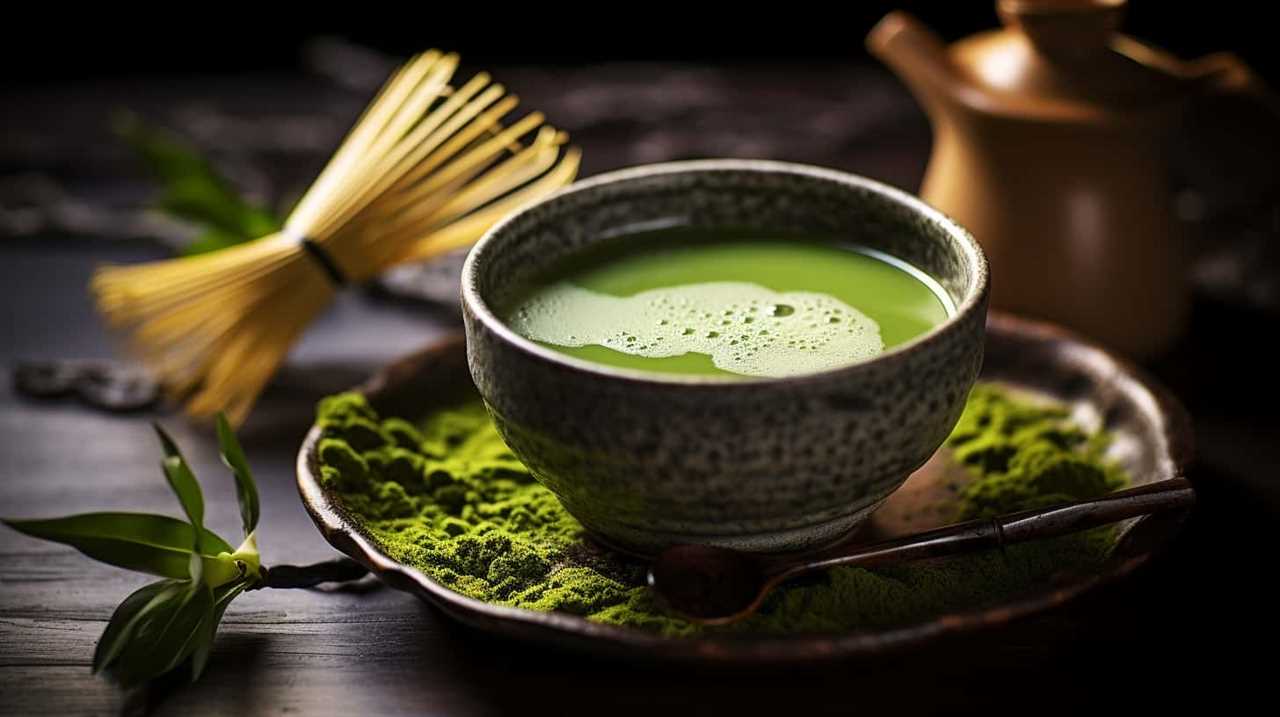
Here are five benefits of shade-grown tea:
- Enhanced flavor: The reduced sunlight increases the amino acid content in the leaves, resulting in a rich, umami flavor.
- Increased chlorophyll: The shading process stimulates the production of chlorophyll, giving the leaves a vibrant green color.
- Higher antioxidant levels: Shade-grown tea contains higher levels of antioxidants, which have numerous health benefits.
- Reduced bitterness: By limiting sunlight, the tea leaves develop fewer tannins, resulting in a smoother, less bitter taste.
- Lower caffeine content: The shade-growing process decreases the caffeine levels in the tea leaves, making it a suitable choice for those sensitive to caffeine.
Tea Flavor Development
In the process of shade-growing matcha tea, we continue to see how the tea flavor develops and intensifies. The unique flavor profiles of matcha tea are a result of various factors that affect its taste.
One of the key factors is the amount of shade the tea plants receive during their growth. By shading the plants, the leaves produce more chlorophyll and amino acids, which contribute to the rich and savory flavor of matcha. The shading process also reduces the bitterness and astringency of the tea, resulting in a smoother and more balanced taste.
Additionally, the duration of the shading period can further influence the flavor. Longer periods of shade-growth can enhance the umami notes and sweetness of the tea.
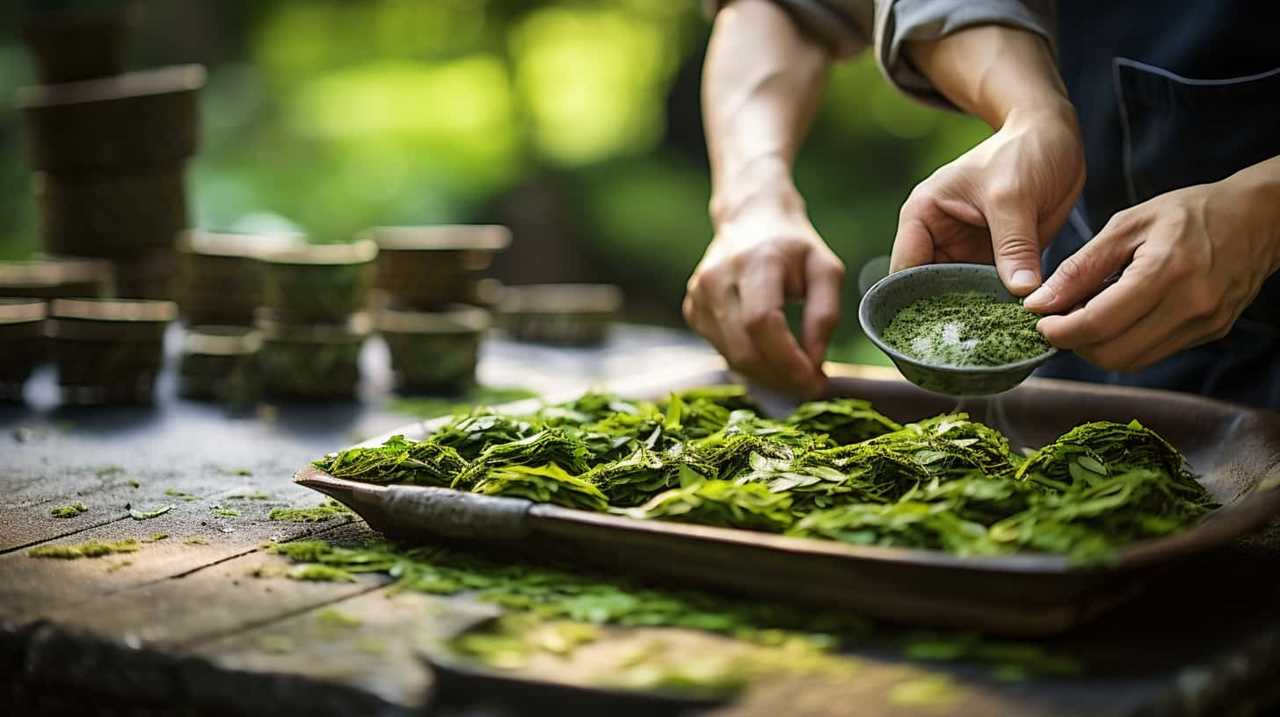
As we explore the tea flavor development in shade-growing, it’s important to also consider its impact on nutrient content.
Impact on Nutrient Content?
By shade-growing matcha tea, we can observe how the nutrient content of the tea is influenced and transformed. The shade-grown process has significant impacts on the nutrient content, leading to various effects on health. Here are five key points to understand the relationship between shade-growing and nutrient content:
- Increased chlorophyll: The reduced sunlight exposure stimulates the production of chlorophyll in the tea leaves, resulting in higher levels of this beneficial compound.
- Enhanced amino acids: Shade-grown matcha tea contains higher amounts of amino acids, such as L-theanine, which contribute to its calming and focus-enhancing effects.
- Reduced catechins: The shading process decreases the levels of catechins, which are responsible for the bitter taste of tea but also have antioxidant properties.
- Retained vitamins and minerals: The shade-grown method helps preserve essential vitamins and minerals, such as vitamin C and potassium, which are vital for overall health.
- Balanced flavor profile: The shade-grown technique creates a well-balanced flavor by reducing the bitterness and enhancing the umami taste, making matcha tea more enjoyable for consumption.
Understanding the impact of shade-growing on nutrient content is crucial for individuals seeking to optimize their health and well-being.
Harvesting Matcha Tea Leaves
We harvest matcha tea leaves during the peak season to ensure their quality and flavor. The timing of the harvest plays a crucial role in the taste and aroma of matcha tea. The leaves are carefully hand-picked by experienced farmers who have mastered the art of cultivating techniques. To give you a better understanding of the process, let’s take a look at the table below:

| Harvesting Time | Flavor Profile |
|---|---|
| First Flush | Fresh and vibrant with a hint of sweetness |
| Second Flush | Rich and robust with a slightly bitter taste |
| Autumn Flush | Earthy and mellow with a subtle sweetness |
The first flush is considered the highest quality as it produces the most delicate and flavorful matcha tea. The second flush, harvested a few weeks later, yields a bolder flavor suitable for those who prefer a stronger taste. Lastly, the autumn flush provides a mellower profile, perfect for those seeking a more balanced and soothing experience.
Steaming the Leaves
After carefully hand-picking the matcha tea leaves during the peak season, our experienced farmers proceed to steam them to preserve their freshness and enhance their vibrant flavors. Steaming the leaves is a crucial step in the matcha tea production process, as it helps to bring out the unique qualities that make matcha so special.
Here are some key points about the tea steaming techniques and the importance of the steaming process:
- Steaming the leaves is done soon after they’re harvested to prevent oxidation and preserve their natural flavors and nutrients.
- The steaming process involves placing the leaves in a steamer for a specific amount of time, depending on the desired flavor profile.
- The steaming helps to soften the leaves, making them easier to grind into a fine powder.
- The steaming also helps to remove any grassy or bitter taste, resulting in a smoother and more delicate flavor.
- The temperature and duration of the steaming process are carefully controlled to ensure optimal results.
By steaming the leaves, we can unlock the full potential of their flavor and aroma, creating a matcha tea that’s both refreshing and enjoyable.
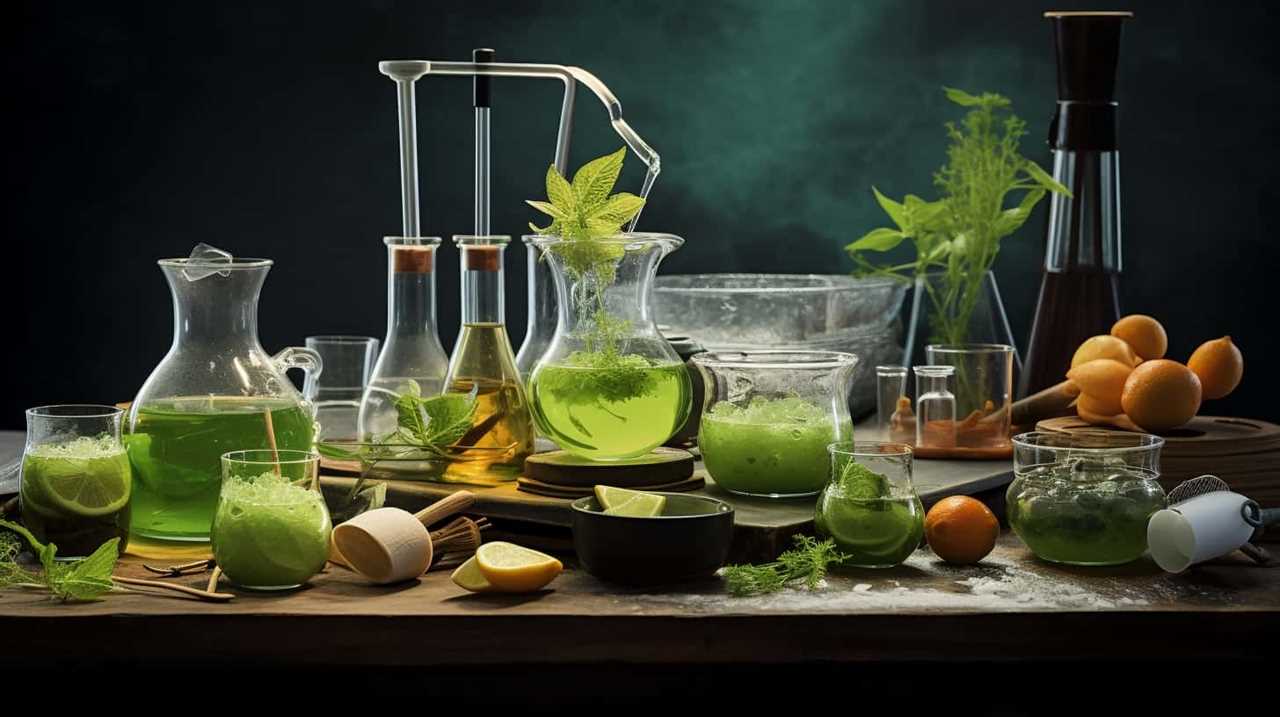
As we move on to the next step of drying and deveining, we’ll continue to handle the leaves with the utmost care and attention to detail, ensuring that every cup of matcha tea we serve is of the highest quality.
Drying and Deveining
Now that the leaves have been steamed to lock in their vibrant green color and preserve their nutrients, the next step in the matcha tea production process is drying and deveining.
Deveining involves removing the stems and veins from the leaves, as they can contribute to a bitter taste.
The drying process can be done through various methods, such as air drying or using special machinery, to ensure the leaves are fully dried and ready for the final steps of grinding and packaging.

Purpose of Deveining
The purpose of deveining, during the process of drying and deveining, is to remove the veins from the matcha tea leaves. Deveining techniques play a crucial role in ensuring the quality and taste of matcha tea.
Here are some benefits of deveining:
- Enhanced flavor: Removing the veins reduces bitterness and astringency, resulting in a smoother and more palatable taste.
- Improved texture: Veins can make the tea leaves coarse and gritty. By removing them, the texture of the matcha becomes smoother, creating a more enjoyable drinking experience.
- Consistency: Deveining ensures that the tea leaves are uniform in texture and appearance, which is essential for producing high-quality matcha.
- Better color: Removing the veins helps the leaves retain their vibrant green color, giving matcha its characteristic hue.
- Enhanced aroma: Deveining allows the leaves to release their natural fragrance, resulting in a more aromatic cup of matcha tea.
Methods of Drying
During the process of drying and deveining, we employ various methods to ensure that the matcha tea leaves are prepared to perfection. The method of drying chosen can greatly impact the final flavor and quality of the matcha.
Hot drying involves using high temperatures to quickly remove moisture from the leaves, resulting in a more intense and robust flavor. On the other hand, cold drying is a slower process that preserves the delicate flavors and aromas of the tea.
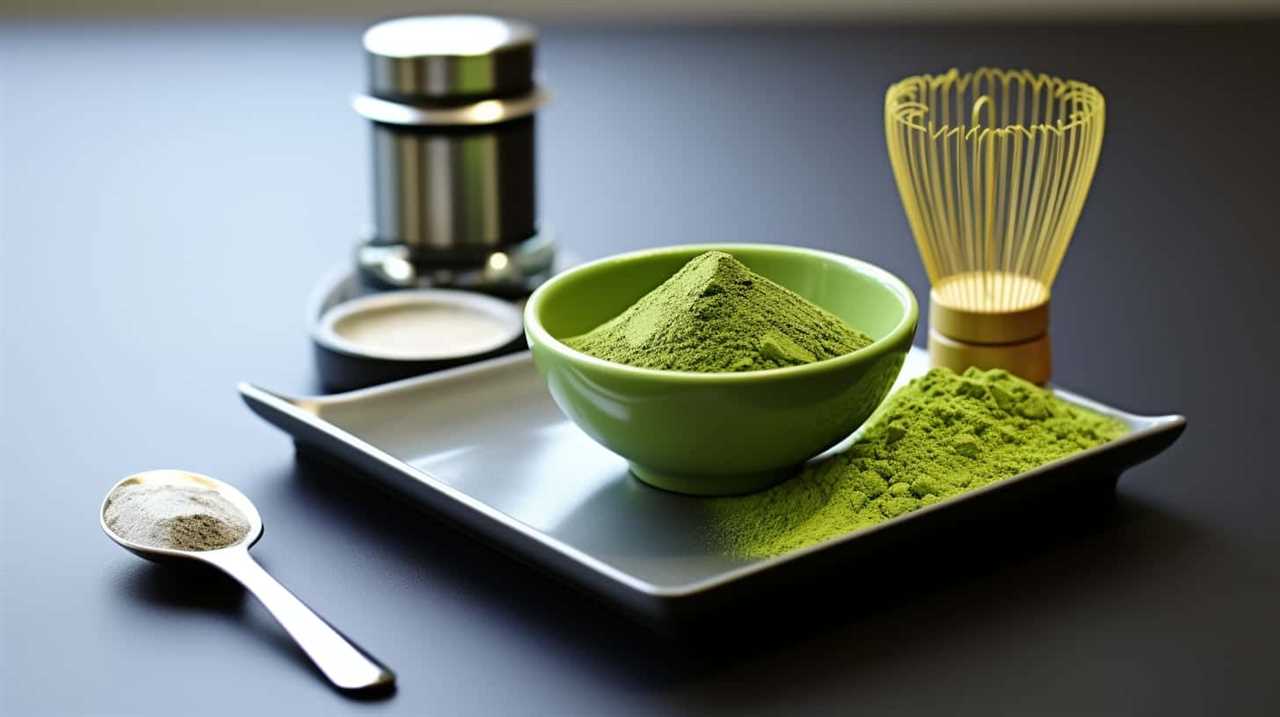
Similarly, air drying involves spreading the leaves in a well-ventilated area to allow for natural evaporation, while sun drying relies on the heat of the sun to dry the leaves. Both methods contribute to enhancing the unique characteristics of the matcha.
Now that the leaves are dried and deveined, they’re ready to be transformed into tencha, the base for matcha.
Tencha: The Base for Matcha
To create matcha tea, we start with the production of tencha, the tea leaves that serve as the base for this vibrant green powder.
Tencha is grown in carefully cultivated soil, rich in nutrients that contribute to its unique flavor profile. The soil composition plays a crucial role in the quality and taste of the tea leaves, as it affects the absorption of nutrients and minerals by the plants.
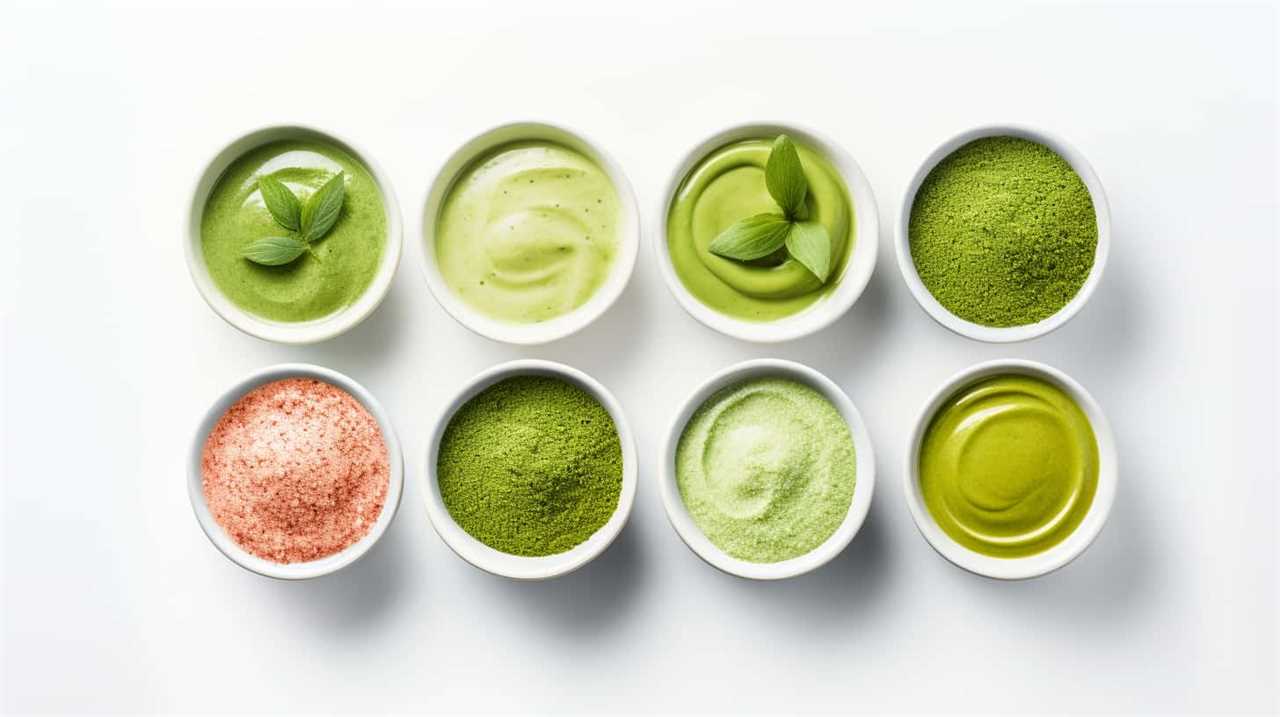
Additionally, the soil composition influences the tea leaf oxidation process, which is a crucial step in matcha production. The leaves are shaded for a specific period, allowing them to develop high levels of chlorophyll and amino acids, resulting in a rich, umami flavor.
After harvesting, the leaves undergo a meticulous steaming and drying process, which helps preserve their vibrant green color and delicate aroma. Finally, the leaves are carefully sorted to remove any impurities before they’re stone-ground into a fine powder. The stone grinding method ensures that the matcha powder retains its unique texture and flavor, creating a smooth and velvety cup of tea.
With the tencha as the base, we’re now ready to explore the next step in the matcha tea-making process.
Stone Grinding Method
For the stone grinding method, we carefully grind the tencha leaves into a fine powder using traditional stone mills. Stone grinding techniques have been used for centuries to produce matcha tea of the highest quality. These stone mills are made from granite, which is known for its durability and ability to retain heat.
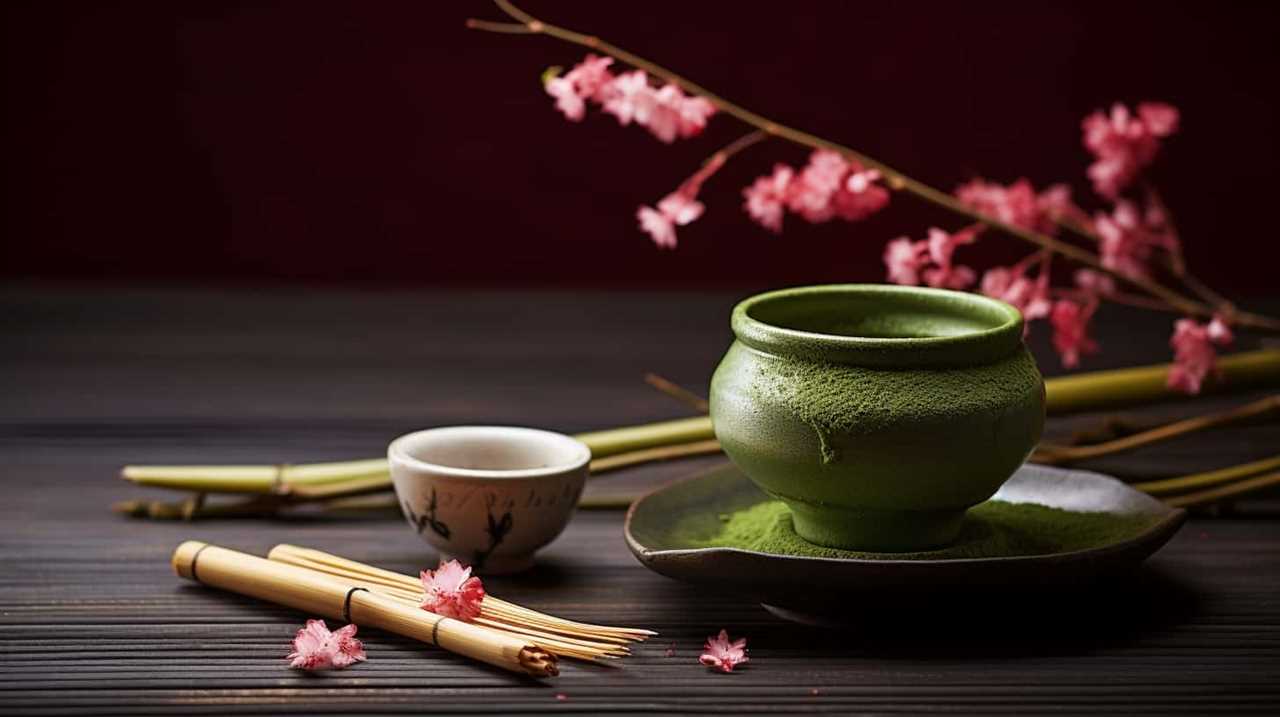
The process begins with carefully selecting the tencha leaves, which are shade-grown to enhance their flavor and increase their chlorophyll content. The leaves are then steamed to prevent oxidation and preserve their vibrant green color. After steaming, the leaves are dried and destemmed before being ground into a fine powder.
The benefits of stone grinding are numerous. Firstly, it allows for a more thorough and even grinding of the leaves, resulting in a smoother and more consistent powder. This ensures that every sip of matcha tea is rich in flavor and aroma. Additionally, the slow and gentle grinding process helps to preserve the nutrients and antioxidants present in the leaves.
This means that when you enjoy a cup of matcha tea made using the stone grinding method, you aren’t only indulging in a delicious beverage, but also nourishing your body with a powerhouse of health benefits. So the next time you sip on a cup of matcha tea, take a moment to appreciate the ancient art of stone grinding that went into creating this exquisite beverage.
Traditional Matcha Tea Tools
In the process of making matcha tea using the stone grinding method, we rely on a set of traditional matcha tea tools. These tools have been used for centuries and are an essential part of the matcha tea-making process. Here are five traditional matcha tea tools that are commonly used:
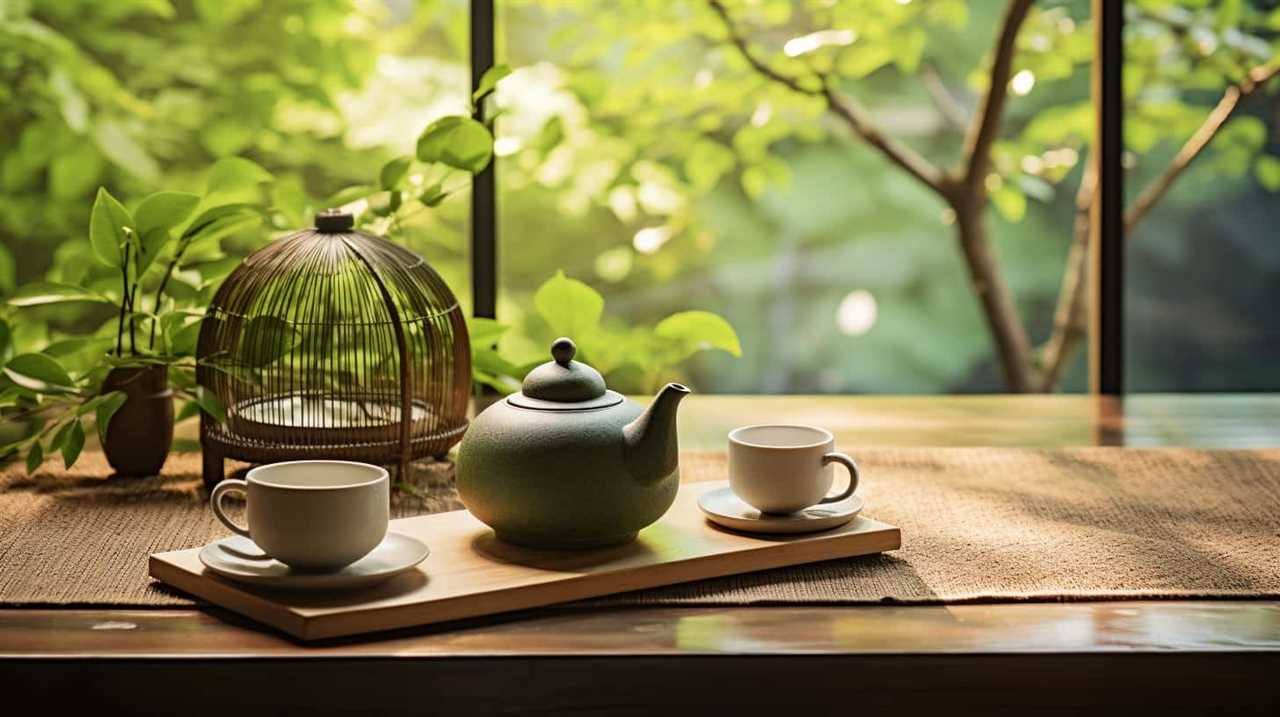
- Chasen (Matcha Whisk): This bamboo whisk is used to whisk the matcha powder and hot water together, creating a frothy and smooth tea.
- Chashaku (Matcha Scoop): This bamboo scoop is used to measure the perfect amount of matcha powder for each serving.
- Chawan (Matcha Bowl): This wide, shallow bowl is used to hold the matcha powder and hot water while whisking.
- Kusenaoshi (Whisk Holder): This tool is used to maintain the shape and integrity of the chasen by allowing it to dry properly.
- Natsume (Tea Caddy): This small, lacquered container is used to store and protect the matcha powder.
While traditional matcha tea tools are still widely used and cherished for their cultural significance, modern matcha tea tools have also emerged. These tools often feature innovative designs and materials that aim to enhance the matcha tea-making experience. However, the traditional matcha tea tools continue to be valued for their authenticity and connection to the rich history of matcha tea.
Now, let’s explore the different grades of matcha tea.
Grades of Matcha Tea
Let’s explore the grades of matcha tea and what sets them apart.
When it comes to matcha, the quality indicators are crucial in determining the grade. From ceremonial grade to culinary grade, each grade has distinct characteristics that affect its taste, color, and texture.
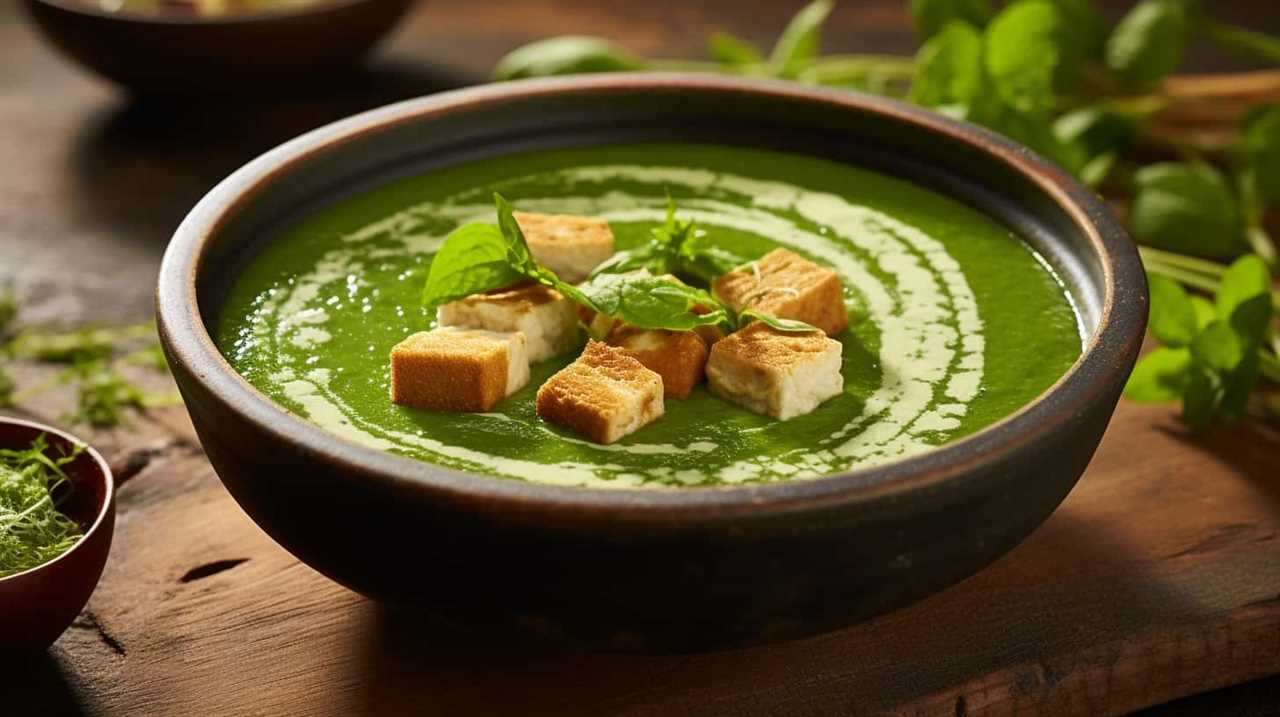
Understanding the differences between matcha grades will help us choose the right one for our desired use, whether it’s for sipping or cooking.
Quality Indicators for Matcha
We will explore the different grades of matcha tea, which serve as quality indicators for this unique beverage. When it comes to tea quality, matcha production follows a strict grading system that ensures consistency and excellence.
Here are some key indicators of matcha quality:
- Color: High-quality matcha is vibrant green, indicating that it was made from young, tender leaves.
- Texture: The finest matcha has a smooth, velvety texture, free from any graininess.
- Aroma: Premium matcha emits a fresh, grassy scent, a sign of its high chlorophyll content.
- Taste: Top-grade matcha boasts a rich, umami flavor with slight sweetness and no bitterness.
- Origin: Matcha from renowned tea-growing regions, such as Uji in Japan, often guarantees superior quality.
Understanding these quality indicators will help you choose the perfect matcha for your enjoyment.

Now, let’s delve into the differences between matcha grades.
Differences Between Matcha Grades
To understand the differences between matcha grades, let’s dive into the various categories that define the quality of this beloved tea. Matcha tea grading is a meticulous process that involves evaluating factors such as color, texture, aroma, taste, and origin. These factors determine the grade of matcha and the overall flavor profile it offers. Here is a breakdown of the different matcha grades and their characteristics:
| Matcha Grade | Characteristics |
|---|---|
| Ceremonial | Vibrant green color, smooth texture, sweet and delicate flavor |
| Premium | Bright green color, slightly coarser texture, rich and umami flavor |
| Culinary | Duller green color, gritty texture, robust and earthy flavor |
Each grade of matcha offers a unique taste experience, allowing you to choose the one that best suits your preferences and intended use. Now that we understand the differences in matcha grades, let’s explore the best uses for this versatile tea.
Best Uses for Matcha
When considering the best uses for matcha tea, it’s important to understand the varying grades of matcha and their distinct flavor profiles. Matcha comes in different grades, each offering unique characteristics that can enhance different culinary recipes and matcha-infused desserts.

Here are the best uses for matcha based on its grades:
- Ceremonial Grade: This highest quality matcha is best enjoyed on its own, whisked with hot water to create a smooth and vibrant tea. Its delicate and sweet flavor profile makes it perfect for traditional tea ceremonies.
- Premium Grade: With a slightly stronger flavor, this grade is still suitable for drinking as a tea. It can also be used for lattes, smoothies, and baked goods, adding a rich and earthy taste.
- Culinary Grade: This grade is specifically made for cooking and baking. Its robust flavor and vibrant green color make it ideal for matcha-infused desserts, such as cakes, cookies, and ice creams.
- Ingredient Grade: Often used in industrial food production, this grade is less expensive and has a more bitter taste. It’s commonly used in recipes that require a strong matcha flavor, such as chocolate truffles or matcha-flavored sauces.
- Kitchen Grade: This grade is the most affordable and has a more astringent taste. It’s suitable for everyday cooking and can be used to add a hint of matcha flavor to savory dishes, such as pasta or sauces.
Understanding the different grades of matcha allows you to choose the right one for your desired culinary creations, ensuring the best flavor and results.
Health Benefits of Matcha Tea
One of the significant health benefits of matcha tea is its high antioxidant content. Antioxidants are compounds that help protect the body against free radicals, which can cause damage to cells and contribute to various health issues, including chronic diseases. Matcha tea is known to contain a specific type of antioxidant called catechins, which are more potent than those found in other types of tea. These catechins have been linked to a range of health benefits, including reducing the risk of heart disease, improving brain function, and supporting weight loss.
Another advantage of matcha tea is its caffeine content. While matcha does contain caffeine, it also contains an amino acid called L-theanine, which has a calming effect on the body. This unique combination of caffeine and L-theanine provides a more sustained energy boost compared to other caffeinated beverages, without the jitters or crash often associated with high caffeine consumption. This makes matcha tea an excellent choice for those looking for a natural and healthy alternative to coffee or energy drinks.

In addition to its antioxidant and caffeine content, matcha tea is also rich in vitamins and minerals. It’s particularly high in vitamin C, vitamin A, and potassium. These nutrients play essential roles in supporting overall health, including a strong immune system, healthy skin, and proper muscle function.
Matcha Tea Ceremonies
Let’s dive into the fascinating world of matcha tea ceremonies and explore the tradition behind this cultural practice.
Matcha tea ceremonies, also known as chanoyu or sado, have been an integral part of Japanese culture for centuries. These ceremonies aren’t just about enjoying a cup of tea, but they embody a deep sense of mindfulness, respect, and appreciation for nature and the present moment.
Here are some key aspects of matcha tea ceremony etiquette and the cultural significance of matcha ceremonies:
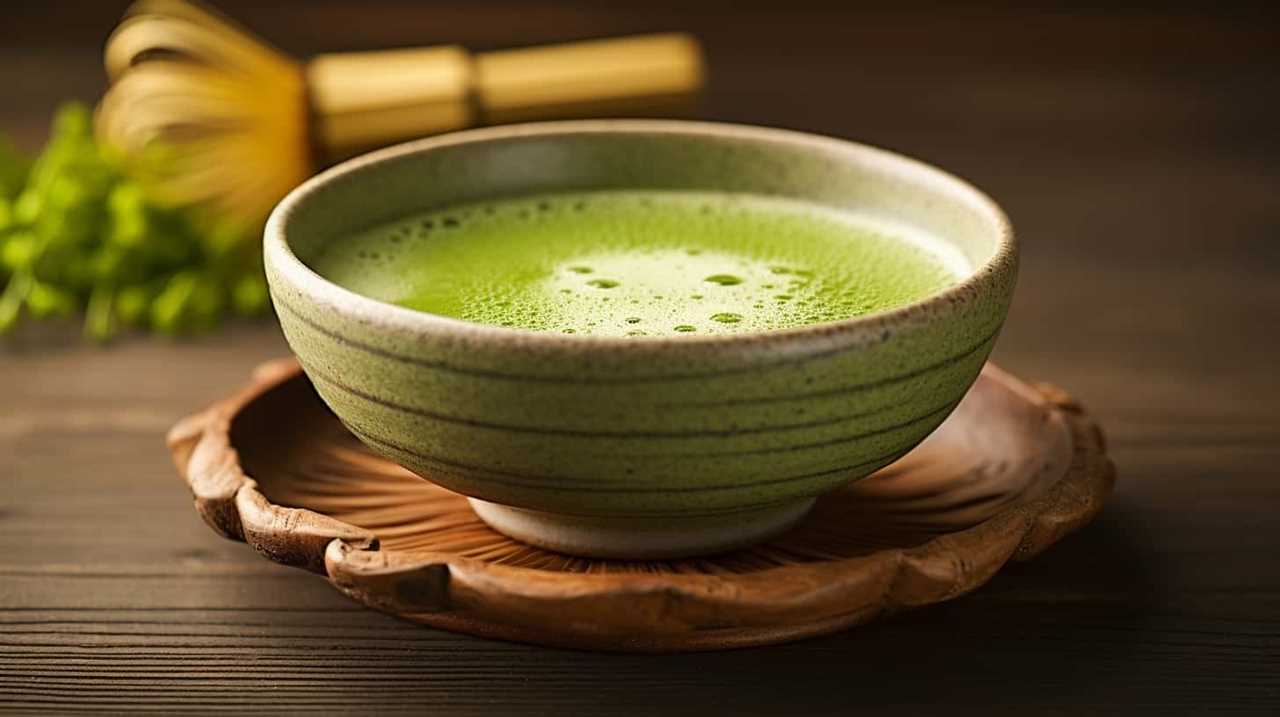
- Seating arrangement: Guests are seated in a specific order, with the most important guest seated closest to the tea master.
- Silence and mindfulness: Participants are encouraged to maintain a peaceful and serene atmosphere during the ceremony, focusing on each movement and moment.
- Ritualized preparation: The tea is carefully prepared by the tea master, following precise techniques and using traditional tools.
- Formal gestures: Guests show respect by bowing to the tea master and using specific hand movements when receiving and drinking the tea.
- Appreciation of beauty: The matcha tea ceremony is an opportunity to admire the aesthetics of the tea utensils, the serene surroundings, and the harmony of the ritual.
Matcha tea ceremonies hold great cultural significance in Japan, representing the values of harmony, respect, purity, and tranquility. The rituals and etiquette followed during these ceremonies reflect the profound connection between humans, nature, and spirituality.
Now that we’ve explored the world of matcha tea ceremonies, let’s move on to discovering the culinary uses of matcha.
Culinary Uses of Matcha
Now, let’s explore the versatility of matcha and how it can be used in various culinary creations. Matcha isn’t only a delightful drink but also a versatile ingredient that can elevate a wide range of dishes. Incorporating matcha into your culinary experiments can lead to exciting and unique flavor pairings.
One popular way to use matcha in cooking is by adding it to baked goods. Its vibrant green color and earthy flavor can add depth to cakes, cookies, and even ice cream. Matcha-infused desserts aren’t only visually appealing but also offer a subtly bitter taste that balances well with the sweetness of other ingredients.
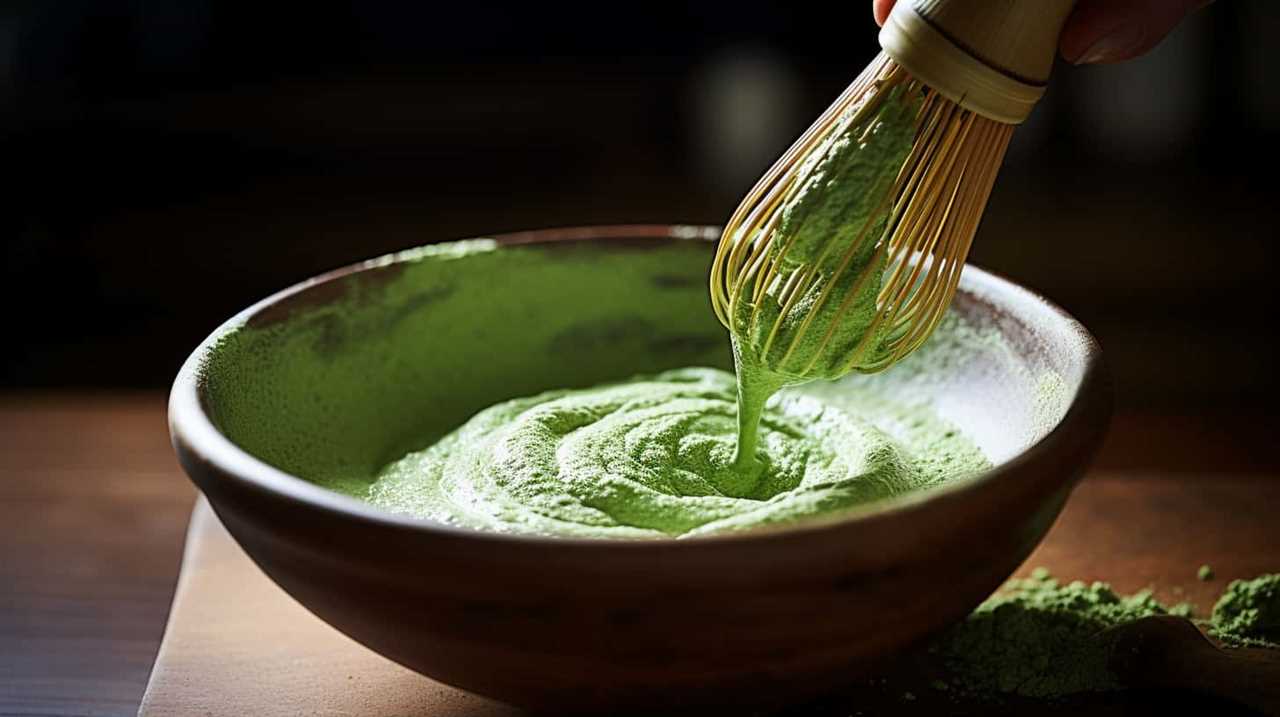
In addition to desserts, matcha can also be used in savory dishes. Its distinct flavor can enhance sauces, dressings, and even marinades. You can experiment with incorporating matcha into traditional recipes or create new, innovative dishes that showcase this unique ingredient.
Tips for Brewing the Perfect Cup of Matcha Tea
To ensure a flavorful and authentic matcha tea experience, it’s important to follow these simple tips for brewing the perfect cup:
- Choose the right temperature: Matcha tea is best brewed with water that’s approximately 175°F (80°C). Boiling water can make the tea bitter, so it’s important to let it cool down for a few minutes before adding it to the matcha powder.
- Use the proper whisking technique: Whisking is a crucial step in making matcha tea. Start by sifting the matcha powder into a bowl to remove any clumps. Then, add a small amount of hot water and use a bamboo whisk to create a smooth, frothy texture. Make quick, back-and-forth motions in a ‘W’ or ‘M’ shape to ensure even whisking.
- Measure the right amount of matcha: For a standard cup of matcha tea, use about 1 teaspoon (2 grams) of matcha powder. Adjust the amount according to your taste preferences.
- Be patient: Take your time when whisking the tea. Rushing the process may result in a less frothy and less enjoyable cup of matcha.
- Enjoy it immediately: Matcha tea is best consumed right after it’s prepared. This ensures that you experience its vibrant flavor and aroma at its peak.
Frequently Asked Questions
How Long Does It Take for Matcha Tea Leaves to Grow From Seed to Harvest?
It takes several weeks for matcha tea leaves to grow from seed to harvest. The exact time can vary depending on factors such as weather, soil conditions, and cultivation methods.
Are There Any Specific Regions Known for Producing the Highest Quality Matcha Tea?
There are specific regions known for producing the highest quality matcha tea. The matcha tea production process involves shading the tea plants, handpicking the leaves, steaming and drying them, and grinding them into a fine powder.
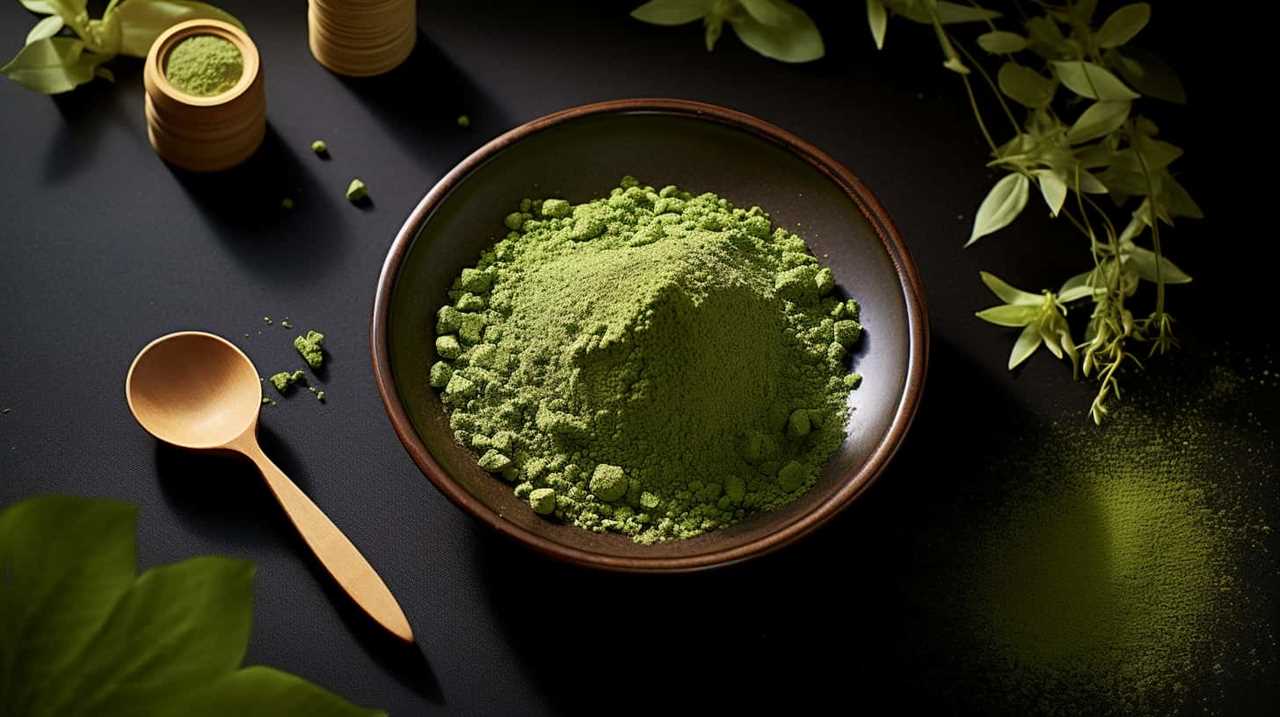
Is Matcha Tea Only Made From a Specific Type of Tea Plant?
Yes, matcha tea is made from a specific type of tea plant called Camellia sinensis. The leaves are grown in shade, harvested, steamed, dried, and ground into a fine powder, creating the vibrant green beverage.
Can Matcha Tea Be Brewed Using Traditional Tea Bags or Does It Require a Special Preparation Method?
Using traditional tea bags to brew matcha tea is not recommended. Matcha requires a special preparation method using a bamboo whisk to achieve its unique frothy texture and full flavor.
Are There Any Specific Storage Recommendations to Maintain the Freshness and Quality of Matcha Tea?
When it comes to maintaining the freshness and quality of matcha tea, there are specific storage recommendations to follow. Properly sealing the tea in an airtight container and storing it in a cool, dark place can help preserve its flavor and aroma.
Conclusion
In conclusion, matcha tea is a unique and ancient beverage that has a rich history and a meticulous cultivation process.

While some may argue that matcha tea is an acquired taste, its health benefits and versatility make it worth exploring.
Whether enjoyed in a traditional ceremony or used in culinary creations, matcha tea offers a one-of-a-kind experience that can be appreciated by tea enthusiasts and health-conscious individuals alike.
So why not give matcha tea a try and discover its captivating flavors and benefits for yourself?
Justin is a seasoned author, coffee and tea enthusiast, and an essential member of the Cappuccino Oracle team. With a keen appreciation for the complexities of coffee, coffee alternatives, and tea, Justin has dedicated his professional career to exploring these realms and sharing his insights with readers worldwide.
Justin’s immersion in the world of coffee, coffee alternatives, and tea began at a young age, kindling a passion that extended beyond mere consumption. This love for these beverages led him to combine his talent for writing with his devotion to coffee and tea, bringing him to Cappuccino Oracle as a dedicated author.
Matcha
Unveiling The Mysteries Of Matcha: Insights On Its Origins, Production, And Quality

Have you ever been curious about the mysteries behind the rich and natural flavors of matcha? If so, get ready to join me on an adventure as we uncover the secrets of matcha, delving into its origins, production, and quality.
As a lover of all things tea, I have delved deep into the world of matcha, immersing myself in its rich history and intricate production process. From the shade-grown tea leaves to the meticulous grinding technique, every step is a labor of love that culminates in the velvety smooth powder we know as matcha.
Join me as we unravel the secrets behind this ancient Japanese tradition and discover why quality is key when indulging in this verdant elixir. We’ll explore the nuances of flavor, the importance of sourcing, and even delve into the fascinating world of other tea varieties.
So grab a cup, sit back, and let’s dive into the captivating world of matcha.
Key Takeaways
- Matcha tea is made from powdered green tea leaves and has a long and labor-intensive production process.
- Premium matcha is made from the first harvest in early spring, using the top 3 sprouts of the tea plant and ground tencha leaves.
- Cheaper matchas may skip some steps in the production process and are more suitable for matcha lattes.
- High-quality matcha is recommended for sparing consumption, as it has a smoother flavor and more health benefits compared to cheaper matchas.
What is matcha?
I’ve learned that matcha is a powdered green tea made from special tea leaves that are shaded before harvest, and it has a long and labor-intensive production process.
There are different types of matcha available, but the premium matcha is made from the first harvest in early spring, using only the top 3 sprouts of the tea plant. The leaves are then steamed, dried, and have their stems removed before being ground into a fine powder using a specialized mill made of granite.
It’s important to note that high-quality matcha is recommended for sparing consumption, as it has a complex production process that results in a smooth flavor. Matcha also offers various health benefits, such as being rich in antioxidants, boosting metabolism, and improving mental alertness.
Production process
The matcha production process involves shading the tea leaves before harvest and selecting the top three sprouts of the tea plant for premium matcha. Shading is a technique used to enhance the flavor and quality of the tea leaves. By covering the tea plants with shade, the leaves produce more chlorophyll and amino acids, resulting in a vibrant green color and a rich, umami taste.
After the shading period, only the top three sprouts of the tea plant are carefully handpicked for premium matcha. These selected leaves, known as tencha leaves, are then steamed, dried, and have their stems removed.
Finally, the tencha leaves are ground into a fine powder using a specialized granite mill. This process results in the smooth and concentrated matcha powder that we enjoy.
Quality and consumption
Let me tell you, indulging in high-quality matcha is like sipping a vibrant green elixir that awakens your taste buds and nourishes your body with its rich flavor and numerous health benefits. Matcha’s health benefits are truly remarkable. Packed with antioxidants, vitamins, and minerals, matcha is known to boost metabolism, enhance focus and concentration, and strengthen the immune system.
But not all matcha is created equal. Different grades of matcha exist, ranging from ceremonial grade to culinary grade. Ceremonial grade matcha is made from the highest quality tencha leaves and has a smooth, vibrant green color and a delicate, umami flavor. It is best enjoyed on its own, whisked with hot water.
On the other hand, culinary grade matcha is more affordable and is suitable for making matcha lattes, smoothies, and baked goods. Although it may have a slightly bitter taste and a duller color, it still provides health benefits.
So, whether you choose to indulge in high-quality ceremonial grade matcha or opt for the more affordable culinary grade, incorporating matcha into your routine is a delicious way to reap its health benefits.
Frequently Asked Questions
What are some popular ways to enjoy matcha besides drinking it as tea?
Besides drinking matcha as tea, some popular ways to enjoy it include indulging in matcha desserts like matcha ice cream, matcha cake, and matcha cookies. Additionally, matcha smoothies are a refreshing and healthy option.
Are there any specific health benefits associated with consuming matcha?
I’m no expert, but matcha is said to have potential health benefits. Some claim it can aid in weight loss due to its high antioxidant content and metabolism-boosting properties. However, more research is needed to confirm these claims.
How does the quality of matcha affect its flavor and overall experience?
The quality of matcha directly affects its flavor and overall experience. Higher quality matcha, made from carefully selected leaves and processed with precision, offers a smoother and more vibrant flavor, while lower quality matcha may have a less appealing taste and color.
Can matcha be used in cooking or baking?
"Where there’s matcha, there’s a way! Matcha can be used in a variety of cooking and baking recipes, adding a vibrant green color and a unique earthy flavor to dishes like matcha desserts."
Are there any specific tips or techniques for properly preparing matcha tea at home?
To properly prepare matcha tea at home, start by sifting the matcha powder to remove any clumps. Then, choose water at around 175°F to 180°F for the best flavor. Gradually add water to the matcha and whisk in a "W" or "M" motion until frothy. Enjoy!
Conclusion
In conclusion, matcha tea is not just a beverage, but a rich and fascinating tradition that has evolved over centuries.
From its origins in Japan to its intricate production process, matcha is a labor of love.
The quality of matcha is crucial, as the steps taken in its production directly impact its flavor and aroma.
Whether you’re a matcha connoisseur or a beginner, there is a matcha tea out there for you.
So, why not indulge in a cup of this vibrant green elixir and experience the magic of matcha for yourself? It’s a journey worth embarking on!
Arf, an author and an innovative enthusiast of coffee, coffee alternatives, and tea, plays a crucial role as a contributor to the esteemed Cappuccino Oracle platform. Renowned for his curiosity and passion for these captivating beverages, Arf has carved out a unique space for himself in the world of exploration and writing. He realized that coffee, coffee alternatives, and tea are not mere drinks to keep one awake, but universes of flavors and stories waiting to be explored.
Arf’s articles for Cappuccino Oracle blend meticulous research with personal experiences, providing readers with an in-depth understanding of various types of coffee, coffee alternatives, and tea, along with their unique characteristics, cultures, and histories. His honest reviews and engaging narratives guide readers on their own journeys, helping them discover their preferences and find their perfect brew.
Matcha
Unveiling The Truth Behind Starbucks’ Matcha: A Disappointing Blend

Being a lover of tea, I was eager to sample Starbucks’ matcha beverages, anticipating a flavorful and genuine taste. However, to my dismay, I found that it was a subpar mixture of inexpensive green tea powder and an excessive amount of sugar. This was a stark contrast to the customary matcha experience that I had grown accustomed to.
The use of low-quality matcha by Starbucks is driven by the need for mass production and a consistent taste across all locations. But in this pursuit, they have sacrificed the true essence of matcha. Authentic matcha production involves meticulous steps to ensure a high-quality and flavorful product, steps that Starbucks seems to skip.
The result is a matcha latte packed with 32 grams of sugar, equivalent to a can of soda, and a whopping 240 calories. It’s time to unveil the truth behind Starbucks’ matcha and explore better options for a truly satisfying tea experience.
Key Takeaways
- Starbucks uses a cheap green tea powder for their matcha drinks, which may not even be considered matcha.
- The cheap matcha powder is mixed with a lot of sugar, negating the health benefits and undermining the quality of the tea.
- Starbucks’ matcha latte contains a high amount of sugar, similar to a can of soda, and has a significant number of calories.
- To have a better matcha experience, it is recommended to explore premium, first harvest matcha made by talented farmers in Japan and to try different matcha options to find preferred taste.
What is Starbucks Matcha?
Starbucks Matcha is a cheap green tea powder mixed with a high amount of sugar, which not only undermines the health benefits of matcha but also fails to deliver the natural, great-tasting flavor of authentic matcha tea.
The ingredients used in Starbucks matcha include low-quality green tea powder that is likely produced on a large scale. Unlike traditional matcha production methods, Starbucks skips certain steps to save time and money. These steps, such as shading the tea plants to reduce bitterness and selecting the top leaves for their flavor and nutrients, are crucial in creating high-quality matcha.
Instead, Starbucks opts for a blend of cheap green tea powder mixed with sugar, resulting in a dull and bitter flavor. This disappointing blend of ingredients does not live up to the standards of true matcha tea.
Quality vs. Cheap Matcha
Indulging in high-quality matcha is like savoring a delicate melody that dances on your taste buds, while settling for cheap matcha is akin to a discordant symphony that leaves a bitter aftertaste. When it comes to matcha, quality matters. Traditional matcha production is an art that requires time, patience, and attention to detail. The importance of shading the tea plants, selecting the top leaves, and using a stone mill to grind the leaves into a fine powder cannot be overstated. These steps not only enhance the flavor but also preserve the health benefits of matcha. High-quality matcha is rich in antioxidants, boosts metabolism, and promotes a sense of calm. On the other hand, cheap matcha often lacks these qualities as it skips crucial steps and is mixed with sugar and other additives. Don’t settle for a subpar matcha experience; choose high-quality matcha for its exceptional taste and health benefits.
| Traditional Matcha Production |
|---|
| Shading the tea plants |
| Selecting the top leaves |
| Grinding with a stone mill |
The importance of traditional matcha production cannot be overstated. These steps not only enhance the flavor but also preserve the health benefits of matcha. High-quality matcha is rich in antioxidants, boosts metabolism, and promotes a sense of calm. On the other hand, cheap matcha often lacks these qualities as it skips crucial steps and is mixed with sugar and other additives. Don’t settle for a subpar matcha experience; choose high-quality matcha for its exceptional taste and health benefits.
Recommendations for Better Matcha
Exploring different matcha options can lead to a better matcha experience. When it comes to matcha, not all options are created equal. While Starbucks may offer a convenient matcha latte, there are alternative options that provide a more authentic and higher quality experience.
Premium matcha, specifically first harvest matcha, is made by talented farmers in Japan and can be enjoyed plain, without the need for excessive sugar or additives. By choosing premium matcha, you can reap the full benefits that matcha has to offer, such as its high antioxidant content and potential health benefits.
Additionally, exploring different types of matcha, such as Japanese black tea, can expand your taste palate and introduce you to new and exciting flavors. So, why settle for a disappointing blend when there are better matcha options out there waiting to be explored?
Frequently Asked Questions
How is Starbucks matcha different from traditional matcha?
Starbucks matcha differs from traditional matcha in terms of quality and taste. One interesting statistic is that Starbucks’ matcha latte contains 32 grams of sugar, similar to a can of soda, which undermines the health benefits of matcha.
What are the health benefits of matcha and how do they differ between Starbucks matcha and premium matcha?
The health benefits of matcha include high levels of antioxidants, increased energy, and improved focus. However, Starbucks matcha quality is compromised due to the use of cheap powder mixed with sugar, negating these benefits.
Can you customize the sweetness level of Starbucks matcha drinks?
Yes, you can customize the sweetness level of Starbucks matcha drinks. They offer popular matcha drink variations like matcha latte and matcha frappuccino, allowing customers to choose the amount of sweetener they prefer.
Are there any alternative options for matcha drinks at Starbucks?
Yes, there are alternative options for matcha drinks at Starbucks. However, it’s important to note that the taste may not be comparable to traditional matcha. Exploring different matcha options and Japanese black tea can provide a better experience.
What are the steps involved in producing high-quality matcha and how does Starbucks’ matcha production differ?
Starbucks’ matcha production process differs from traditional matcha production in Japan. High-quality matcha involves shading the tea plants, selecting the top leaves, steaming, drying, and grinding them. However, Starbucks skips these steps, resulting in a lower quality and less authentic matcha experience.
Conclusion
In conclusion, after delving into the truth behind Starbucks’ matcha, it’s clear that their blend falls short of expectations. The use of cheap green tea powder mixed with excessive sugar dilutes any potential health benefits and fails to deliver an authentic matcha experience.
To truly enjoy the rich and flavorful taste of matcha, it’s recommended to explore premium, first harvest options crafted by skilled Japanese farmers. Don’t settle for subpar matcha; treat yourself to a tea experience that’ll leave your taste buds dancing with delight.
Arf, an author and an innovative enthusiast of coffee, coffee alternatives, and tea, plays a crucial role as a contributor to the esteemed Cappuccino Oracle platform. Renowned for his curiosity and passion for these captivating beverages, Arf has carved out a unique space for himself in the world of exploration and writing. He realized that coffee, coffee alternatives, and tea are not mere drinks to keep one awake, but universes of flavors and stories waiting to be explored.
Arf’s articles for Cappuccino Oracle blend meticulous research with personal experiences, providing readers with an in-depth understanding of various types of coffee, coffee alternatives, and tea, along with their unique characteristics, cultures, and histories. His honest reviews and engaging narratives guide readers on their own journeys, helping them discover their preferences and find their perfect brew.
Matcha
The Ultimate Guide To Using Chashaku: Your Matcha Essential

Being a lover of matcha, I am aware that the crucial factor in achieving the perfect matcha bowl is the equipment we utilize. When it comes to preparing matcha, there is one tool that is particularly essential: the chashaku.
This bamboo spoon, with its elegant design and precise measurements, is the secret weapon of matcha lovers worldwide. In this ultimate guide, I will take you on a journey through the history and evolution of the chashaku, and show you how to use it like a pro.
From its origins as a metal or ivory scoop to its modern-day incarnation in bamboo, the chashaku has come a long way. With its 48° bend and 18mm length, it effortlessly scoops the perfect amount of matcha from its container.
So grab your chashaku and get ready to elevate your matcha game to new heights. Let’s dive in and discover the wonders of this matcha essential.
Key Takeaways
- Chashaku is a bamboo spoon used to scoop matcha powder in the Japanese tea ceremony and by matcha lovers worldwide.
- Chashaku is one of the three important tea utensils used in the tea ceremony and is about 18mm in length with a 48° bend at the end for scooping.
- Chashaku is made of bamboo to avoid negative reactions with matcha powder and is a great measurement tool for matcha powder.
- Two scoops of chashaku is the standard amount for a bowl of matcha tea, and it is easy to maneuver in matcha tins or natsume due to its small size.
What is Chashaku?
Chashaku is a bamboo spoon used to scoop matcha powder, and it’s one of the three important tea utensils used in the Japanese tea ceremony.
Made from a single piece of bamboo, this elegant tool has a long history dating back to the Muromachi period in Japan. Originally crafted from metal or ivory, chashaku evolved to be made of bamboo due to its natural properties and to avoid any negative reactions with matcha powder.
The design of chashaku is both functional and beautiful, with a length of about 18mm and a 48° bend at the end for easy scooping. There are different styles of chashaku scoops, each with its own unique shape and characteristics. The back of the chashaku has a rough texture, while the face is smooth and sleek.
Whether you’re a matcha lover or a tea ceremony enthusiast, using a chashaku adds a touch of authenticity and tradition to your matcha preparation.
History and Evolution
During the Muromachi period in Japan, the chashaku spoon evolved from being made of metal or ivory to its current bamboo form, which is about 18mm in length and has a 48° bend at the end for easier scooping. The history and evolution of the chashaku is a testament to its significance in Japanese tea ceremonies and its cultural importance in matcha preparation.
| The significance of chashaku in Japanese tea ceremonies | The cultural importance of chashaku in matcha preparation |
|---|---|
| Chashaku is one of the three important tea utensils used in the tea ceremony. | Chashaku is a great measurement tool for matcha powder. |
| Chashaku originated in Japan during the Muromachi period. | Chashaku’s small size allows for easy maneuvering in matcha tins or natsume. |
| Originally made of metal or ivory, chashaku evolved to be made of bamboo. | Chashaku is made from a single piece of bamboo and shaped with a bend for the scoop. |
| Chashaku is made of bamboo to avoid negative reactions with matcha powder. | The back of chashaku has a rough texture, while the face is smooth and sleek. |
The chashaku’s role in Japanese tea ceremonies cannot be understated. It is one of the three essential utensils used in the tea ceremony, alongside the chawan (tea bowl) and chasen (tea whisk). The chashaku’s small size and precise measurement make it the perfect tool for scooping matcha powder. Its evolution from metal or ivory to bamboo shows the cultural importance placed on this utensil. The chashaku’s design, with its gentle bend and smooth face, allows for easy and graceful scooping of matcha. Using the chashaku is not only practical but also a way to honor the centuries-old tradition of matcha preparation.
How to Use Chashaku
To use the chashaku, I simply hold it like a pencil and dip the scoop into the matcha container. Then, I carefully lift the chashaku scoop out and place it over the matcha bowl to dump the powder.
It’s a simple and elegant technique that ensures the perfect amount of matcha every time.
But did you know that there are alternative ways to use the chashaku? Some matcha lovers prefer to use a teaspoon or a regular spoon to scoop their matcha powder. While these alternatives may work in a pinch, they don’t offer the same precision and authenticity as the chashaku.
The chashaku’s unique design and size make it the ideal tool for measuring matcha powder. Plus, using the chashaku adds a traditional touch to the matcha preparation process, enhancing the overall experience.
So why settle for anything less? Embrace the chashaku and elevate your matcha game to the next level.
Frequently Asked Questions
What are the different types of materials used to make chashaku besides bamboo?
There’s something truly magical about the chashaku, the bamboo spoon that gracefully scoops matcha powder. While bamboo is the traditional material, chashaku can also be made from metal or ivory, although these alternatives are less common.
Can chashaku be used to scoop other powders besides matcha?
Yes, chashaku can be used to scoop other powders besides matcha. However, it is primarily designed for scooping matcha powder and is most commonly used in Japanese tea ceremonies. To properly clean and care for a chashaku, it is recommended to wipe it with a dry towel or tissue to avoid water damage. The chashaku is a versatile tool with different uses in the tea ceremony, making it an essential item for matcha lovers.
How long does a chashaku typically last before it needs to be replaced?
A chashaku typically lasts for a long time, but the lifespan can vary depending on the material. Bamboo chashaku is the most common and durable option, while metal or ivory may wear down over time. Proper care involves cleaning with a dry towel or tissue to avoid water damage.
Can chashaku be used with different types of matcha bowls or is it specific to a certain style?
Absolutely! Chashaku can be used with various types of matcha bowls, adapting to different styles. Its small size and unique design make it perfect for scooping matcha powder and adding a touch of elegance to your matcha preparation.
Are there any alternative utensils that can be used in place of chashaku for scooping matcha powder?
Yes, there are alternative utensils for scooping matcha powder, such as a teaspoon or a small spoon. However, using a chashaku has its benefits. Its unique design allows for precise measurements and easy maneuvering in matcha tins.
Conclusion
In conclusion, using chashaku isn’t just a practical way to measure and scoop matcha powder, but it’s also an essential tool for embracing the art and tradition of the Japanese tea ceremony.
While some may argue that using a regular spoon can achieve the same result, chashaku offers a unique experience that connects us to centuries of tea culture. Imagine holding the slender bamboo spoon, feeling the weight of tradition in your hand, and delicately scooping the vibrant green matcha powder.
It’s a sensory journey that brings us closer to the beauty and mindfulness of matcha preparation. So, embrace the chashaku, and let it elevate your matcha experience to new heights.
Arf, an author and an innovative enthusiast of coffee, coffee alternatives, and tea, plays a crucial role as a contributor to the esteemed Cappuccino Oracle platform. Renowned for his curiosity and passion for these captivating beverages, Arf has carved out a unique space for himself in the world of exploration and writing. He realized that coffee, coffee alternatives, and tea are not mere drinks to keep one awake, but universes of flavors and stories waiting to be explored.
Arf’s articles for Cappuccino Oracle blend meticulous research with personal experiences, providing readers with an in-depth understanding of various types of coffee, coffee alternatives, and tea, along with their unique characteristics, cultures, and histories. His honest reviews and engaging narratives guide readers on their own journeys, helping them discover their preferences and find their perfect brew.
-

 Americano4 weeks ago
Americano4 weeks agoHow to Make Americano With Moka Pot
-

 Americano2 weeks ago
Americano2 weeks agoHow to Make Korean Iced Americano
-

 Americano4 weeks ago
Americano4 weeks agoHow to Make Americano With Bialetti
-

 Americano4 weeks ago
Americano4 weeks agoHow to Make Dutch Bros Americano
-

 Americano1 week ago
Americano1 week agoHow to Make an Iced Americano With Nespresso
-

 Americano2 weeks ago
Americano2 weeks agoHow Many Shots of Espresso for 16 Oz Americano
-

 Americano4 weeks ago
Americano4 weeks agoHow to Make a Hazelnut Americano
-

 Turmeric Tea1 week ago
Turmeric Tea1 week agoTurmeric Saffron Tea

















